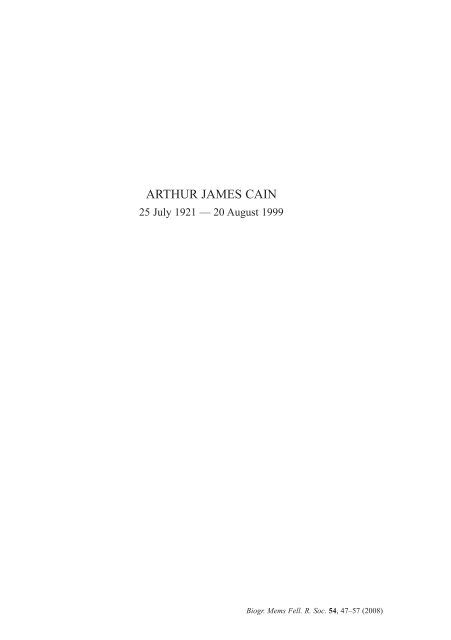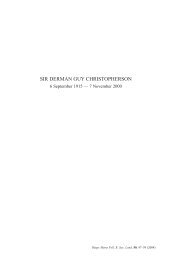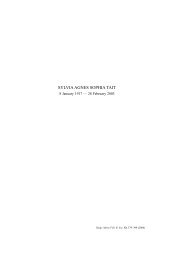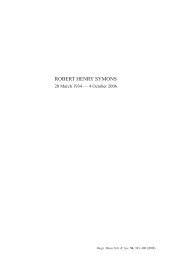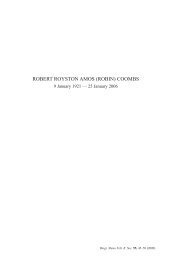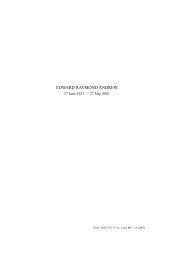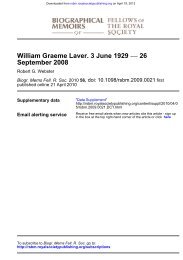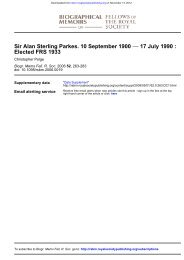arthur james cain - Biographical Memoirs of Fellows of the Royal ...
arthur james cain - Biographical Memoirs of Fellows of the Royal ...
arthur james cain - Biographical Memoirs of Fellows of the Royal ...
Create successful ePaper yourself
Turn your PDF publications into a flip-book with our unique Google optimized e-Paper software.
ARTHUR JAMES CAIN<br />
25 July 1921 — 20 August 1999<br />
Biogr. Mems Fell. R. Soc. 54, 47–57 (2008)
ARTHUR JAMES CAIN<br />
25 July 1921 — 20 August 1999<br />
Elected FRS 1989<br />
BY BRYAN C. CLARKE FRS<br />
Institute <strong>of</strong> Genetics, Queens Medical Centre, University <strong>of</strong> Nottingham,<br />
Clifton Boulevard, Nottingham NG7 2UH, UK<br />
Arthur Cain was a polymath, and one <strong>of</strong> Britain’s leading evolutionary biologists. A strong<br />
believer in, and advocate for, <strong>the</strong> importance <strong>of</strong> natural selection, he greatly influenced evolutionary<br />
thought during <strong>the</strong> period from <strong>the</strong> 1950s to <strong>the</strong> 1980s. He wrote important papers in<br />
many areas <strong>of</strong> biology, and he was a noted historian <strong>of</strong> science.<br />
LIFE AND CAREER<br />
Arthur was born in Rugby, Warwickshire, <strong>the</strong> son <strong>of</strong> James Peter Cain and Margaret<br />
Susan, née Goodall. His fa<strong>the</strong>r was <strong>of</strong> Manx and Welsh descent, and his mo<strong>the</strong>r came from<br />
Wiltshire. He wrote firmly that he had ‘no distinguished relatives on ei<strong>the</strong>r side’*. His<br />
secondary education took place at <strong>the</strong> local boys’ grammar school in Rugby, <strong>the</strong> Lawrence<br />
Sheriff School, which he entered in 1931. There he came under <strong>the</strong> influence <strong>of</strong> an outstanding<br />
teacher, Wilfred Kings. Kings managed very effectively to generate enthusiasm for<br />
biology among his pupils. Cain wrote, ‘I am sure whatever I have achieved in field work<br />
owes a lot to his patient encouragement. He was an ideal master for those who really wanted<br />
to learn.’ Several <strong>of</strong> Kings’s students became well-known biologists. They included John<br />
Harper FRS, Gerald Thompson, who was <strong>the</strong> founder <strong>of</strong> <strong>the</strong> Oxford Natural History Film<br />
Unit, and A. F. L. Clowes, who gained an open exhibition at Magdalen College and became<br />
Reader in Botany.<br />
When discussing his intellectual development, Arthur drew attention to <strong>the</strong> fact that <strong>the</strong><br />
town <strong>of</strong> Rugby had an unusually good public library, as a result <strong>of</strong> <strong>the</strong> international scheme<br />
<strong>of</strong> apprenticeships at <strong>the</strong> British Thompson Houston factory. He also mentioned an abundance<br />
* Unattributed quotations are taken from Arthur’s Personal Record deposited in <strong>the</strong> Library <strong>of</strong> <strong>the</strong> <strong>Royal</strong> Society.<br />
doi:10.1098/rsbm.2007.0034 49 This publication is © 2008 The <strong>Royal</strong> Society
50 <strong>Biographical</strong> <strong>Memoirs</strong><br />
<strong>of</strong> wildlife within easy reach, much <strong>of</strong> it suitable for maintenance in aquaria. He enjoyed <strong>the</strong><br />
local cement quarries, where he searched <strong>the</strong> spoil heaps for Jurassic fossils, and occasionally<br />
trespassed into <strong>the</strong> quarries <strong>the</strong>mselves.<br />
In 1939 Arthur won a Demyship (<strong>the</strong> most prestigious scholarship) at Magdalen College,<br />
Oxford. He was tutored by J. Z. Young (FRS 1945), and emerged with first-class honours in<br />
zoology after a course that was truncated because <strong>of</strong> World War II. He <strong>the</strong>n served as a Second<br />
Lieutenant in <strong>the</strong> <strong>Royal</strong> Army Ordnance Corps, and later transferred to <strong>the</strong> <strong>Royal</strong> Electrical<br />
and Mechanical Engineers. He was promoted to Captain in 1942. A large part <strong>of</strong> his wartime<br />
service was carried out in <strong>the</strong> Orkney Islands, where he was responsible for anti-aircraft radar,<br />
protecting <strong>the</strong> ships <strong>of</strong> <strong>the</strong> fleet. December 1945 brought him back to Oxford for some fur<strong>the</strong>r<br />
tuition by Peter (later Sir Peter) Medawar (FRS 1949, and Nobel laureate), and for work<br />
towards a DPhil, which he finished in 1948. During this time, he met and married, in 1947,<br />
Joyce Perrott, who was reading ma<strong>the</strong>matics at St Hilda’s College. Their daughter, Celia, and<br />
<strong>the</strong>ir son, David, were born in 1948 and 1951, respectively. He was appointed Departmental<br />
Demonstrator in Zoology, and in 1949 became a university demonstrator (equivalent to a<br />
lecturer) in animal taxonomy.<br />
He spent six months in 1950 working with Ernst Mayr (ForMemRS 1988) at <strong>the</strong> American<br />
Museum <strong>of</strong> Natural History, and lecturing at Harvard, Yale and several o<strong>the</strong>r eastern universities.<br />
In 1954 he was made Curator <strong>of</strong> Zoological Collections in <strong>the</strong> University Museum at<br />
Oxford, alongside his lectureship. From 1958 to 1961 he was also Lecturer in Zoology at St<br />
Peter’s Hall, Oxford.<br />
He led two expeditions, one to <strong>the</strong> Solomon Islands in 1953 and one to Guyana (<strong>the</strong>n British<br />
Guiana) in 1959. The trip to <strong>the</strong> Solomons enabled him to study <strong>the</strong> correlations between geographical,<br />
ecological, and morphological variation among <strong>the</strong> endemic birds. He also visited<br />
New Guinea. In British Guiana he examined <strong>the</strong> comparative ecology <strong>of</strong> closely related bird<br />
species within its tropical forests. Because <strong>of</strong> his experience in <strong>the</strong> tropics he was chosen, in<br />
1961, to represent Oxford University on <strong>the</strong> Inter-Universities Committee for research at Lake<br />
Kariba. He acted as <strong>the</strong> scientific secretary to this committee in <strong>the</strong> UK, and during this period<br />
he made several trips to Kariba and Johannesburg. In 1965 he went to <strong>the</strong> Serengeti National<br />
Park, once more working on avian ecology. In 1983 he joined an expedition to <strong>the</strong> Dominican<br />
Republic, where he concentrated on <strong>the</strong> ecology and distribution <strong>of</strong> terrestrial molluscs.<br />
In 1964 he became Pr<strong>of</strong>essor <strong>of</strong> Zoology at <strong>the</strong> University <strong>of</strong> Manchester, and in 1968 he<br />
moved to <strong>the</strong> Derby Pr<strong>of</strong>essorship <strong>of</strong> Zoology at <strong>the</strong> University <strong>of</strong> Liverpool, where he stayed<br />
until he retired in 1988.<br />
Cain served as Editor <strong>of</strong> <strong>the</strong> Biological Series for Hutchinson’s University Library from<br />
1967 to 1975. He was an Associate Editor <strong>of</strong> Malacologia, and a member <strong>of</strong> <strong>the</strong> Advisory<br />
Board for Bolletino de Zoologia. He was appointed as Advisor in Biology for <strong>the</strong> Science<br />
Research Council from 1972 to 1975. In 1976 he became President <strong>of</strong> Section D (Zoology)<br />
<strong>of</strong> <strong>the</strong> British Association for <strong>the</strong> Advancement <strong>of</strong> Science. He became a Founder Member<br />
<strong>of</strong> <strong>the</strong> Society for <strong>the</strong> Study <strong>of</strong> Human Biology, President <strong>of</strong> <strong>the</strong> Oxford Genetical Society,<br />
Zoological Secretary and President <strong>of</strong> <strong>the</strong> Systematics Association, Member <strong>of</strong> <strong>the</strong> Council <strong>of</strong><br />
<strong>the</strong> Linnean Society and Fellow <strong>of</strong> <strong>the</strong> Institute <strong>of</strong> Biology. He was chosen to be <strong>the</strong> founding<br />
President <strong>of</strong> <strong>the</strong> European Society for Evolutionary Biology in 1987, and to be an Honorary<br />
Member <strong>of</strong> <strong>the</strong> Malacological Society in 1991.<br />
He made lecture tours in Australia, Canada, Israel and <strong>the</strong> USA. In 1986 he was Herbert<br />
Spencer Lecturer at <strong>the</strong> University <strong>of</strong> Oxford. He received <strong>the</strong> Scientific Medal <strong>of</strong> <strong>the</strong>
Arthur James Cain 51<br />
Zoological Society <strong>of</strong> London in 1962, and its Frink Medal in 1990. He was awarded <strong>the</strong><br />
Linnean Medal for Zoology in 1985, and <strong>the</strong> Founder’s Medal <strong>of</strong> <strong>the</strong> Society for <strong>the</strong> History<br />
<strong>of</strong> Natural History in 1995. He had a long association with <strong>the</strong> Academy <strong>of</strong> Natural Sciences<br />
in Philadelphia, and was made a Fellow in 1976.<br />
SCIENTIFIC CONTRIBUTIONS<br />
Arthur studied for <strong>the</strong> DPhil under <strong>the</strong> supervision <strong>of</strong> Dr John R. Baker, who was <strong>the</strong>n a<br />
lecturer in <strong>the</strong> Department <strong>of</strong> Zoology. Arthur told how he came to study under Baker. Peter<br />
Medawar had suggested that he should go round <strong>the</strong> staff to see what <strong>the</strong>y were all doing.<br />
I started with <strong>the</strong> room next door, where was John R. Baker FRS, and got no fur<strong>the</strong>r—he’d just<br />
invented a histochemical test and as I was extremely fond <strong>of</strong> test tube chemistry I stayed with<br />
him. I could not have done better. He taught me an extremely practical and critical approach to<br />
<strong>the</strong> subject and inspired me with his wonderful enthusiasm and incredible range <strong>of</strong> knowledge and<br />
competence. From <strong>the</strong>n on, I was free <strong>of</strong> <strong>the</strong> superstition that if a paper looked scientific and had<br />
awe inspiring chemical and o<strong>the</strong>r formulae, it was necessarily any good.<br />
His work with Baker involved studies on <strong>the</strong> histochemistry <strong>of</strong> lipoids and on <strong>the</strong> structure <strong>of</strong><br />
<strong>the</strong> Golgi apparatus. ‘John Baker should have been co-author <strong>of</strong> some <strong>of</strong> my papers in lipoid<br />
histochemistry, but he wouldn’t hear <strong>of</strong> it. He was a man <strong>of</strong> complete integrity.’<br />
Arthur’s <strong>the</strong>sis resulted in 12 papers, one <strong>of</strong> which, published in 1947 (1)*, on <strong>the</strong> use <strong>of</strong><br />
Nile Blue in <strong>the</strong> examination <strong>of</strong> lipoids, became a ‘Citation Classic’ in 1989. Arthur was asked<br />
to write a commentary about it, and characteristically observed (19):<br />
Surely <strong>the</strong>re are far better techniques for separating lipoids now; <strong>the</strong> paper should have been<br />
superseded years ago. I’ve never regretted my work on lipoid histochemistry; it showed me that<br />
papers can be decorated with recondite structural formulae and based on apparently scientific<br />
procedures and still be worthless. This paper had no impact on my fur<strong>the</strong>r career. What it all really<br />
shows is <strong>the</strong> heterogeneity <strong>of</strong> <strong>the</strong> class <strong>of</strong> citation classics. To call this paper a classic (however<br />
qualified) because people have gone on citing it (I hope while improving or rejecting it, but I fear<br />
not) is downright misleading.<br />
While he was studying for <strong>the</strong> DPhil, Arthur became a mentor <strong>of</strong> Philip Sheppard (FRS<br />
1965), who had just returned from being a prisoner <strong>of</strong> war. Arthur wrote:<br />
He appealed immediately to my love <strong>of</strong> natural history, and showed me how he and his super visor,<br />
E. B. Ford FRS, were tackling <strong>the</strong> problems <strong>of</strong> evolution and natural selection practically in <strong>the</strong><br />
wild.<br />
Sheppard was probably <strong>the</strong> biggest single influence on me. I think our own findings <strong>of</strong> massive<br />
selection in Cepaea have influenced me most, though <strong>the</strong> fact that Ford, R. A. Fisher and<br />
Sheppard were finding selection on <strong>the</strong> apparent trivialities <strong>of</strong> wing-pattern variation in <strong>the</strong> scarlet<br />
tiger moth was nearly as important. I’m still working out some <strong>of</strong> <strong>the</strong> consequences for evolutionary<br />
<strong>the</strong>ory, and have rejected most <strong>of</strong> Mayr’s and Stephen J. Gould’s ideas in consequence—<strong>the</strong>y<br />
are not founded on actual studies <strong>of</strong> selection.<br />
After his DPhil, Arthur turned his attention to evolution and systematics, interests that<br />
lasted him for <strong>the</strong> rest <strong>of</strong> his life. The transition may have been helped by his histochemical<br />
* Numbers in this form refer to <strong>the</strong> bibliography at <strong>the</strong> end <strong>of</strong> <strong>the</strong> text.
52 <strong>Biographical</strong> <strong>Memoirs</strong><br />
work on <strong>the</strong> neurons <strong>of</strong> snails, which coincidentally drew his attention to <strong>the</strong> extraordinary<br />
colour polymorphism in Cepaea nemoralis. Sheppard was interested in <strong>the</strong> significance <strong>of</strong><br />
genetically determined polymorphisms in natural populations, and Arthur introduced him to<br />
<strong>the</strong> variation in Cepaea. This resulted in a long-term collaboration and friendship between<br />
<strong>the</strong>m. At <strong>the</strong> time, <strong>the</strong> variation was regarded as neutral, and unimportant to <strong>the</strong> survival or<br />
reproduction <strong>of</strong> <strong>the</strong> snails. This view was reinforced by <strong>the</strong> work <strong>of</strong> Maxime Lamotte (Lamotte<br />
1951), who, in a large and influential paper, fitted <strong>the</strong> frequencies <strong>of</strong> Cepaea morphs to <strong>the</strong><br />
equations <strong>of</strong> random genetic drift. Cain and Sheppard found it difficult to believe that <strong>the</strong><br />
variation was neutral, and <strong>the</strong>y tested Lamotte’s hypo<strong>the</strong>sis by studying <strong>the</strong> extremely various<br />
habitats in which C. nemoralis occurs (woods, hedgerows, grasslands, and habitats containing<br />
mixtures <strong>of</strong> herbaceous plants). In <strong>the</strong> region <strong>of</strong> Oxford <strong>the</strong>y found repeatable patterns <strong>of</strong><br />
morph frequencies, with higher proportions <strong>of</strong> yellow and banded shells in grasslands and<br />
rough herbage, but with higher proportions <strong>of</strong> brown, pink and unbanded shells in woodlands.<br />
The differences were highly significant. Cain and Sheppard interpreted <strong>the</strong>se regularities as<br />
being due to natural selection by thrushes, which are major predators <strong>of</strong> Cepaea. The thrushes<br />
have a convenient habit <strong>of</strong> smashing snail shells on stones, around which may accumulate <strong>the</strong><br />
remains <strong>of</strong> tens or hundreds <strong>of</strong> broken shells. Later experiments, using snails that had been<br />
marked on <strong>the</strong>ir shells, allowed Cain and Sheppard to demonstrate that thrushes did indeed<br />
exert differential selection on <strong>the</strong> morphs. Their 1954 paper on Cepaea (3) has become a classic<br />
in ecological and evolutionary genetics.<br />
Arthur’s studies on Cepaea reached a new level <strong>of</strong> complexity when, in 1963, he and John<br />
Currey discovered curious patterns <strong>of</strong> gene frequencies on <strong>the</strong> Marlborough Downs (15).<br />
These patterns, which <strong>the</strong>y called ‘area effects’, involved relatively uniform morph frequencies<br />
over areas much larger than those occupied by single populations. The frequencies bore<br />
little relationship to <strong>the</strong> habitats as defined by vegetation. Similar patterns were subsequently<br />
found in o<strong>the</strong>r locations in <strong>the</strong> British Isles. There seemed to be two regional alternatives,<br />
one with clear associations between vegetable habitats and gene frequencies, and <strong>the</strong> o<strong>the</strong>r<br />
with patterns <strong>of</strong> area effects. Cain and Currey interpreted <strong>the</strong> latter as being manifestations <strong>of</strong><br />
variation in microclimates, arguing that <strong>the</strong> frequency <strong>of</strong> brown shells increased where <strong>the</strong>re<br />
was ‘ponding’ <strong>of</strong> cold air. O<strong>the</strong>r workers, for example Goodhart (1963), argued that <strong>the</strong> area<br />
effects were due to random genetic drift. Later work by Robert Cameron and his colleagues<br />
(Cameron & Dillon 1984) has indicated that such patterns are <strong>the</strong> results <strong>of</strong> changes in land<br />
use. In <strong>the</strong> regions where area effects are found, C. nemoralis has been restricted in <strong>the</strong> past to<br />
a few refuges within which differentiation occurred, ei<strong>the</strong>r by natural selection or by random<br />
genetic drift. Subsequently, <strong>the</strong> snails would have repopulated intervening habitats, spreading<br />
out to form <strong>the</strong> area effects. It is still a matter <strong>of</strong> debate whe<strong>the</strong>r <strong>the</strong> differentiation in <strong>the</strong><br />
refuges has been largely due to selection or to drift, but <strong>the</strong> existence <strong>of</strong> area effects itself is<br />
certainly not evidence against selection.<br />
In regions <strong>of</strong> Britain where <strong>the</strong> colours <strong>of</strong> shells in <strong>the</strong> Cepaea populations are adjusted<br />
to <strong>the</strong> backgrounds <strong>of</strong> <strong>the</strong>ir habitats, Cain and Sheppard found that <strong>the</strong> colours <strong>of</strong> <strong>the</strong> snails’<br />
s<strong>of</strong>t bodies were similarly associated, albeit only in shades <strong>of</strong> brownish grey. This was fur<strong>the</strong>r<br />
evidence <strong>of</strong> natural selection. During and after <strong>the</strong>ir work on C. nemoralis, Arthur and his colleagues<br />
performed ecological and genetic studies on several o<strong>the</strong>r species <strong>of</strong> pulmonate land<br />
snails, including Cepaea hortensis, Theba pisana, Trichia striolata and Helix aspersa.<br />
Arthur soon became interested in <strong>the</strong> shapes <strong>of</strong> snails as well as <strong>the</strong>ir colours. He considered<br />
<strong>the</strong> ratio between shell height and breadth, examining <strong>the</strong> ratio in many gastropod taxa.
Arthur James Cain 53<br />
He showed that variations in shape between species within higher taxa are <strong>of</strong>ten bimodal. By<br />
surveying <strong>the</strong> entire molluscan faunas <strong>of</strong> islands and regions, he was able to relate particular<br />
shapes to particular habitats and ways <strong>of</strong> life. He could <strong>the</strong>n estimate <strong>the</strong> extent to which<br />
‘shape niches’ are filled in terrestrial ecosystems. As Laurence Cook remarked, ‘The basic<br />
information was available to all, but Arthur had <strong>the</strong> insight to make it matter in evolutionary<br />
biology’ (Cook 2000).<br />
In 1954 (4) and 1956 (7) Cain and Sheppard published two important critiques <strong>of</strong><br />
Dobzhansky’s and Li’s views on polymorphism, pointing out that <strong>the</strong> terms ‘adaptive polymorphism’<br />
and ‘adaptive value’ can be very misleading when respectively <strong>the</strong>y mean ‘selected<br />
polymorphism’ and ‘selective value’. Selection does not necessarily lead to adaptation,<br />
particularly when selective values are related to frequencies in <strong>the</strong> population. The ‘average<br />
adaptive value’ (w – ) is in no sense a measure <strong>of</strong> adaptation. Unfortunately, modern students <strong>of</strong><br />
molecular evolution have followed Dobzhansky’s usage, and equated selection and adaptation<br />
to <strong>the</strong> considerable detriment <strong>of</strong> clear thinking. Cain and Sheppard’s two papers on this subject<br />
should be recommended reading today.<br />
The work on Cepaea convinced Arthur that it is always a mistake to assume that a character<br />
is selectively neutral without a careful study <strong>of</strong> its biological effects and <strong>the</strong>ir relations<br />
to <strong>the</strong> ecology and habits <strong>of</strong> <strong>the</strong> organism. Moreover, a prima-facie belief in neutrality can<br />
hold up progress because it discourages fur<strong>the</strong>r observations and experiments. On occasion<br />
Arthur’s enthusiasm to make this argument led him apparently to imply that <strong>the</strong> null hypo<strong>the</strong>sis<br />
should be selection ra<strong>the</strong>r than neutrality, a strategy that is <strong>of</strong> course impracticable. Arthur<br />
was inspired to accumulate evidence about <strong>the</strong> power and delicacy <strong>of</strong> natural selection, and<br />
he summarized his views trenchantly in a widely quoted article (16), which was reprinted in<br />
1989 (18).<br />
After his experiences in British Guiana, <strong>the</strong> Solomon Islands and <strong>the</strong> Dominican Republic,<br />
Arthur became very interested in <strong>the</strong> process <strong>of</strong> adaptive radiation. As he wrote to Ernst Mayr,<br />
‘My visit to <strong>the</strong> neo-tropical region has had a reinforcing effect on what I saw in <strong>the</strong> Solomons<br />
and Australia, and ADAPTIVE RADIATION is now written firmly all over my frontal lobes.<br />
I see it as <strong>the</strong> most outstanding <strong>of</strong> all evolutionary phenomena.’* He was drawn to work on<br />
<strong>the</strong> Australasian and Oceanian birds (6, 9), an interest that led him to analyse how taxonomic<br />
decisions are reached, to study <strong>the</strong> methods <strong>of</strong> Linnaeus, and to consider <strong>the</strong> philosophy and<br />
history <strong>of</strong> pre- and post-Linnaean developments in systematics (10, 12, 13, 20). He made an<br />
early attempt, with Ge<strong>of</strong>frey Harrison, to create a method for numerical taxonomy (11, 14).<br />
Arthur gave much attention to <strong>the</strong> concepts <strong>of</strong> species (2) and genera (8), and was inspired<br />
in 1954 to produce an excellent short book, Animal species and <strong>the</strong>ir evolution (5), reprinted<br />
by Princeton University Press in 1993 with a new ‘Afterword’. His convictions about <strong>the</strong><br />
power <strong>of</strong> natural selection persuaded him that convergent evolution is common enough to<br />
make <strong>the</strong> construction <strong>of</strong> phylogenies from anatomical characters extremely insecure. He<br />
became a campaigner against Hennig’s cladistic arguments as well as against ‘neutralists’ who<br />
attributed <strong>the</strong> larger part <strong>of</strong> organic evolution to <strong>the</strong> random sampling <strong>of</strong> genetic variants. He<br />
also took strong exception to Stephen Jay Gould’s advocacy <strong>of</strong> chance and ‘contingency’ in<br />
<strong>the</strong> evolutionary process.<br />
* This letter, with most <strong>of</strong> Cain’s scientific correspondence, is deposited in <strong>the</strong> library <strong>of</strong> <strong>the</strong> American Philosophical<br />
Society at Philadelphia, alongside <strong>the</strong> papers <strong>of</strong> his friend and colleague, Pr<strong>of</strong>essor Philip Sheppard FRS.
54 <strong>Biographical</strong> <strong>Memoirs</strong><br />
PERSONALITY<br />
Arthur Cain cared passionately about science, and his enthusiasm was very appealing, particularly<br />
to younger students and colleagues. John Turner writes:<br />
I was very deeply impressed by his erudition and powers <strong>of</strong> communication, and must have spent<br />
excessively long tea breaks sitting at Arthur’s table in <strong>the</strong> library along with his graduate students<br />
lapping it all up. He became in a way my un<strong>of</strong>ficial supervisor. … I never burdened Arthur with<br />
any questions about my own research and he probably never knew what I was doing. It was just<br />
general education. I loved his interest in <strong>the</strong> history and philosophy <strong>of</strong> biology. He was a fountain<br />
<strong>of</strong> quotations: what impressed me was his memory for prose.<br />
Laurence Cook writes:<br />
I first met Arthur when interviewed as a prospective research student. After some wary sparring on<br />
both sides I mentioned that <strong>the</strong> animal I proposed to study was at <strong>the</strong> edge <strong>of</strong> its range, and <strong>the</strong>refore<br />
likely to show clear evidence <strong>of</strong> ecological limiting factors. ‘Ah, peripheral populations’, he<br />
said, and I was treated to a 40-minute monologue on all aspects <strong>of</strong> <strong>the</strong> subject. After that I was in,<br />
and learned that this was one <strong>of</strong> his favoured patterns <strong>of</strong> communication. Generations <strong>of</strong> research<br />
students remember Arthur holding forth and developing his ideas during tea and c<strong>of</strong>fee breaks.<br />
A vast range <strong>of</strong> biological topics was covered and <strong>the</strong> enthusiasm was infectious. The ebullience<br />
… had its negative side, he was sensitive to disagreement and tended to take it as personal criticism.<br />
This had one compensation, because to get over a perceived setback he would take up a<br />
completely different topic.<br />
He talked, as an equal, with experts in many obscure animal and plant groups. His style <strong>of</strong><br />
supervision was a sort <strong>of</strong> benign neglect. He was <strong>the</strong>re to help if asked, but o<strong>the</strong>rwise left one<br />
alone. His help was given freely, and it included <strong>the</strong> gift <strong>of</strong> some <strong>of</strong> his data. However, he never<br />
asked to put his name on any <strong>of</strong> <strong>the</strong> papers. It is a pity that this example is not followed today.<br />
David Parkin, who was a research student <strong>of</strong> Arthur’s in Manchester, has written about <strong>the</strong> total<br />
extent <strong>of</strong> his supervision. In <strong>the</strong> first year Arthur said, ‘I think you ought to work on Arianta<br />
arbustorum, David.’ In <strong>the</strong> second year David was given 35 minutes <strong>of</strong> supervision, and in <strong>the</strong><br />
third year Arthur said, ‘I’m glad you got something useful out <strong>of</strong> that piece <strong>of</strong> work.’<br />
Cain’s passion about science quite <strong>of</strong>ten got <strong>the</strong> better <strong>of</strong> him. He tended to view people<br />
in black and white. They were ei<strong>the</strong>r brilliant or monstrous, and at one time or ano<strong>the</strong>r most<br />
<strong>of</strong> his colleagues had been both. At meetings and seminars he was liable to explode, and <strong>the</strong>n<br />
storm out angrily. At o<strong>the</strong>r times he would be entirely charming.<br />
In <strong>the</strong> bad times, he would retire gloomily into himself. Then it was difficult to get a word<br />
out <strong>of</strong> him. The transition between enthusiasm and gloom was <strong>of</strong>ten quick, apparently precipitated<br />
by some imagined or real slight but also, as his daughter Celia reports, because <strong>of</strong><br />
very bad migraines.<br />
John Turner writes, ‘He used to sit … by that pond in <strong>the</strong> middle <strong>of</strong> <strong>the</strong> courtyard at <strong>the</strong><br />
Zoology Department, daring anyone to come and speak to him, and <strong>the</strong>n when somebody did,<br />
would complain that nobody wanted to speak to him because he was a failure.’<br />
He applied for <strong>the</strong> chairs at Oxford and Durham, was <strong>of</strong>fered Durham, but turned it down<br />
because Joyce very much preferred to stay in Oxford. When John Pringle got Oxford, Arthur<br />
contacted Durham saying that he would like to accept after all, only to find it had already gone<br />
to someone else. One can see why he felt miserable about it.<br />
With all <strong>the</strong>se ups and downs, working in his company was never dull. He created a sense<br />
<strong>of</strong> excitement about <strong>the</strong> subjects that interested him. He was angered by people who, as he saw
Arthur James Cain 55<br />
Figure 1. Watercolour by Arthur Cain inspired by Out <strong>of</strong> <strong>the</strong> silent planet by C. S. Lewis; <strong>the</strong> painting represents Meldilorn.<br />
(Online version in colour.)<br />
it, had forsaken <strong>the</strong> true paths <strong>of</strong> scientific virtue and <strong>the</strong>reby had become managerially important.<br />
He made his contempt for <strong>the</strong>m very evident, which did not endear him to university<br />
administrations, and may well have hindered <strong>the</strong> progress <strong>of</strong> <strong>the</strong> departments for which he was<br />
responsible. He was certainly not a good administrator himself, but he created an intellectual<br />
atmosphere in which ideas flowed continuously, and were continuously challenged.<br />
Arthur had a very wide range <strong>of</strong> interests and talents, which included painting (figure 1)<br />
and music (on occasion he would carry about a suitcase containing recorders <strong>of</strong> various sizes,<br />
which he used to play with my daughter when she was small). He and Joyce shared an enthusiasm<br />
for <strong>the</strong>ir garden in Hoylake.<br />
George Davis wrote (Davis 2000):<br />
Those who knew him marveled at his ability for total recall <strong>of</strong> world-wide species <strong>of</strong> plants and<br />
animals, his knowledge <strong>of</strong> geology, to say nothing <strong>of</strong> his ability to reconstruct <strong>the</strong> architectural<br />
history <strong>of</strong> ca<strong>the</strong>drals <strong>of</strong> Europe (stone by stone and porch by porch), or to entertain one by sitting<br />
in a rocking chair and ‘reading’ Tolkein’s Hobbit (without <strong>the</strong> book!), giving flawless renditions<br />
<strong>of</strong> Shakespeare’s sonnets from memory, or quoting endless poems and doggerel by Edward Lear,<br />
and from <strong>the</strong> Cautionary Verses <strong>of</strong> Hilaire Belloc.<br />
Despite Arthur’s tendencies to combat, he was <strong>of</strong>ten very perceptive. Here are two examples,<br />
written 20 years ago (17), that illustrate his style:<br />
The contrast between <strong>the</strong> potential rapidity <strong>of</strong> cultural … evolution and <strong>the</strong> slowness <strong>of</strong> genetic<br />
evolution is certainly striking. But what is <strong>of</strong> far more immediate importance is that between<br />
cultural evolution and <strong>the</strong> rate <strong>of</strong> human reproduction. Without any nuclear holocausts, it is more<br />
than likely that at least <strong>the</strong> terrestrial parts <strong>of</strong> <strong>the</strong> planet will be ecologically and economically
56 <strong>Biographical</strong> <strong>Memoirs</strong><br />
ruined in half a century, simply because cultural evolution is too slow. … as Lawton has said, no<br />
politically viable alternative has been presented to <strong>the</strong> multiplying myriads <strong>of</strong> <strong>the</strong> world. … It is no<br />
good standing in line, singing ‘Woodman, spare that tree!’ to a shifting cultivator with a wife and<br />
children to feed who is about to demolish <strong>the</strong> last patch <strong>of</strong> rain-forest in his neighbourhood.<br />
Intellectuals no doubt are individually biased; never<strong>the</strong>less by <strong>the</strong>ir … conflicts with one ano<strong>the</strong>r<br />
and, in science, by appeal to actual experiment, <strong>the</strong>y can progress towards a more objective<br />
appreciation <strong>of</strong> <strong>the</strong> world. … What <strong>the</strong>y have to realize is that <strong>the</strong>y are more probably among<br />
<strong>the</strong> evolutionary eccentrics, having (some <strong>of</strong> <strong>the</strong>m at least) remained children in <strong>the</strong>ir curiosity<br />
and exploration <strong>of</strong> <strong>the</strong> world, than representative <strong>of</strong> mankind in general. Periods in history when<br />
discussion has been genuinely free are very few, very short, and <strong>of</strong>ten followed by repression or<br />
downright persecution. … It is more than possible that in Britain we are coming to <strong>the</strong> end <strong>of</strong><br />
one such golden period; Dorothy Nelkin’s book on <strong>the</strong> conflict <strong>of</strong> fundamentalism and science<br />
in <strong>the</strong> USA documents <strong>the</strong> immense strides made by irrationalism in that country <strong>of</strong> glorious<br />
freedom. Certainly <strong>the</strong> culturally retarded politicians that can see in a Vice-Chancellor only a<br />
works manager, and in a university only a source <strong>of</strong> cheap technological information; who in <strong>the</strong><br />
name <strong>of</strong> efficiency are removing all safeguards to intellectual freedom and concentrating power<br />
in <strong>the</strong> hands <strong>of</strong> <strong>the</strong> few to ensure ‘efficient’ running; and those whose only criterion <strong>of</strong> value in<br />
appraising research is <strong>the</strong> amount <strong>of</strong> money successfully acquired and spent on a piece <strong>of</strong> work;<br />
are very unlikely to respond to any long-term plans. There will be enough quislings inside <strong>the</strong><br />
universities to abet <strong>the</strong>m.<br />
Arthur Cain was survived by his wife Joyce, who died in 2005, <strong>the</strong>ir son David and <strong>the</strong>ir<br />
daughter, Celia Tew.<br />
ACKNOWLEDGEMENTS<br />
I am very grateful indeed to <strong>the</strong> following people for <strong>the</strong>ir help in <strong>the</strong> writing <strong>of</strong> this memoir: Mr David Cain,<br />
Pr<strong>of</strong>essor L. M. Cook, Mrs C. Gill, Pr<strong>of</strong>essor J. J. D. Greenwood, Pr<strong>of</strong>essor G. A. Parker FRS, Pr<strong>of</strong>essor D. T.<br />
Parkin, Mrs Celia Tew and Pr<strong>of</strong>essor J. R. G. Turner. Particular thanks go to Pr<strong>of</strong>essor J. J. Murray for his kindness<br />
in researching <strong>the</strong> Cain archive at The American Philosophical Society.<br />
The frontispiece photograph was provided by Arthur Cain’s family.<br />
REFERENCES TO OTHER AUTHORS<br />
Cameron, R. A. D. & Dillon, P. J. 1984 Habitat stability, population histories and patterns <strong>of</strong> variation in Cepaea.<br />
Malacologia 25, 271–290.<br />
Cook, L. M. 2000 A J Cain FRS 1921–1999 Bull. Malac. Soc. Lond. 34, 2–3.<br />
Davis, G. M. 2000 Arthur J. Cain 1921–1999. Proc. Acad. Natl Sci. Philad. 150, 1–2.<br />
Goodhart, C. B. 1963 ‘Area effects’ and non-adaptive variation between populations <strong>of</strong> Cepaea (Mollusca). Heredity<br />
18, 459–465.<br />
Lamotte, M. 1951 Recherches sur la structure génétique des populations naturelles de Cepaea nemoralis (L.) Bull.<br />
Biol. Suppl. 35, 1–239.<br />
OTHER ACCOUNTS OF ARTHUR CAIN<br />
Claridge, M. 2000 Obituary. Pr<strong>of</strong>essor Arthur J. Cain FLS FRS. A personal reminiscence. Linnean 16, 39–41.<br />
Clarke, B. 1999 Arthur James Cain (1921–99); naturalist and doughty Darwinian. Nature 401, 872.<br />
Clarke, B. & Parkin, D. T. 1989 Pr<strong>of</strong>essor Arthur James Cain. Biol. J. Linn. Soc. 36, 1–2.
Arthur James Cain 57<br />
BIBLIOGRAPHY<br />
The following publications are those referred to directly in <strong>the</strong> text. A full bibliography is<br />
available as electronic supplementary material at http://dx.doi.org/10.1098/rsbm.2007.0034<br />
or via http://journals.royalsociety.org.<br />
(1) 1947 The use <strong>of</strong> Nile Blue in <strong>the</strong> examination <strong>of</strong> lipoids. Q. J. Microsc. Sci. 88, 383–392.<br />
(2) 1953 Geography, ecology and coexistence in relation to <strong>the</strong> biological definition <strong>of</strong> <strong>the</strong> species. Evolution 7,<br />
76–83.<br />
(3) 1954 (With P. M. Sheppard) Natural selection in Cepaea. Genetics 39, 89–116.<br />
(4) (With P. M. Sheppard) The <strong>the</strong>ory <strong>of</strong> adaptive polymorphism. Am. Nat. 88, 321–326.<br />
(5) Animal species and <strong>the</strong>ir evolution. London: Hutchinson’s University Library.<br />
(6) 1955 A revision <strong>of</strong> Trichoglossus haematodus and <strong>of</strong> <strong>the</strong> Australian platycercine parrots. Ibis 97, 432–479.<br />
(7) 1956 (With P. M. Sheppard) Adaptive and selective value. Am. Nat. 90, 202–203.<br />
(8) The genus in evolutionary taxonomy. Syst. Zool. 5, 97–109.<br />
(9) 1957 Range-changes and differential selection in fruit pigeons <strong>of</strong> <strong>the</strong> Ptilinopus purpuratus species-group.<br />
Proc. 8th Pacific Sci. Congr. 31, 1393–1412.<br />
(10) 1958 Logic and memory in Linnaeus’s system <strong>of</strong> taxonomy. Proc. Linn. Soc. Lond. 169, 125–128.<br />
(11) (With G. A. Harrison) An analysis <strong>of</strong> <strong>the</strong> taxonomist’s judgement <strong>of</strong> affinity. Proc. Zool. Soc. Lond.<br />
131, 85–98.<br />
(12) 1959 Deductive and inductive methods in post-Linnaean taxonomy. Proc. Linn. Soc. Lond. 170, 185–217.<br />
(13) The post-Linnaean development <strong>of</strong> taxonomy. Proc. Linn. Soc. Lond. 170, 234–244.<br />
(14) 1960 (With G. A. Harrison) Phyletic weighting. Proc. Zool. Soc. Lond. 135, 1–31.<br />
(15) 1963 (With J. D. Currey) Area effects in Cepaea. Phil. Trans. R. Soc. B 246, 1–81.<br />
(16) 1964 The perfection <strong>of</strong> animals. Viewpoints Biol. 3, 36–63.<br />
(17) 1988 Evolution. Plenary address given by <strong>the</strong> President <strong>of</strong> <strong>the</strong> European Society for Evolutionary Biology,<br />
on <strong>the</strong> occasion <strong>of</strong> <strong>the</strong> Society’s founding congress, 26 August 1987, in Basel. J. Evol. Biol. 1, 185–<br />
194.<br />
(18) 1989 The perfection <strong>of</strong> animals (reprinted from Viewpoints In Biology vol. 3: 36–63, 1964). Biol. J. Linn.<br />
Soc. 36, 3–29.<br />
(19) Validation <strong>of</strong> a histochemical test—a Citation Classic commentary on <strong>the</strong> use <strong>of</strong> Nile Blue in <strong>the</strong><br />
examination <strong>of</strong> lipoids by Cain AJ. Curr. Contents/Clin. Med. (29), 16.<br />
(20) 1995 Linnaeus’s natural and artificial arrangements <strong>of</strong> plants. Bot. J. Linn. Soc. 117, 73–133.


